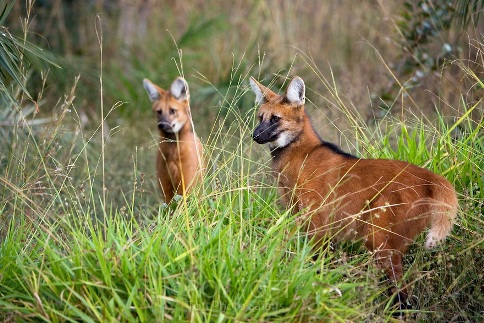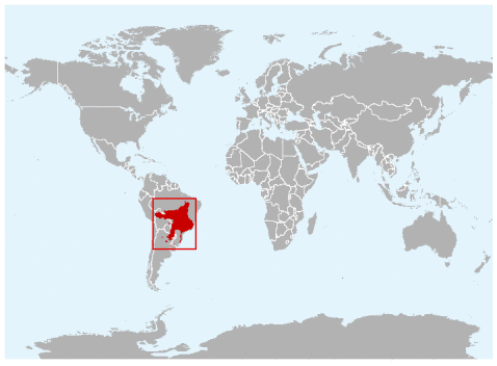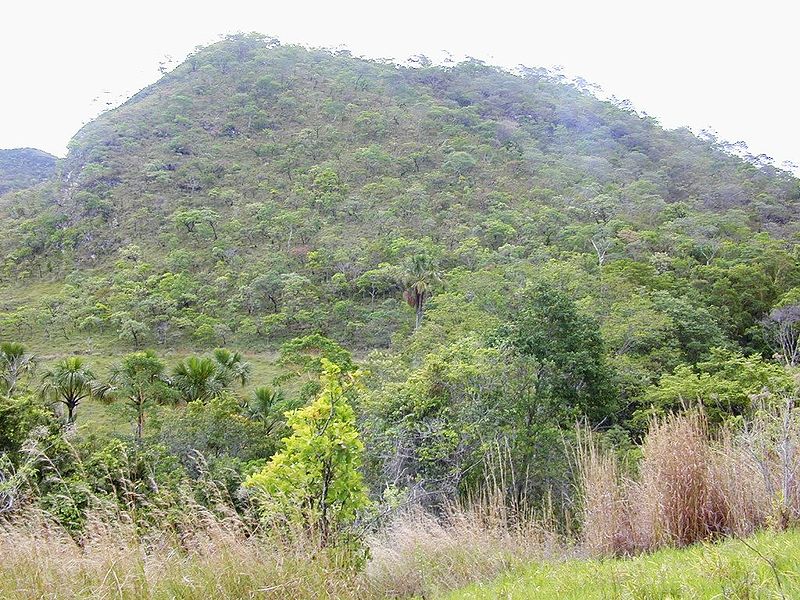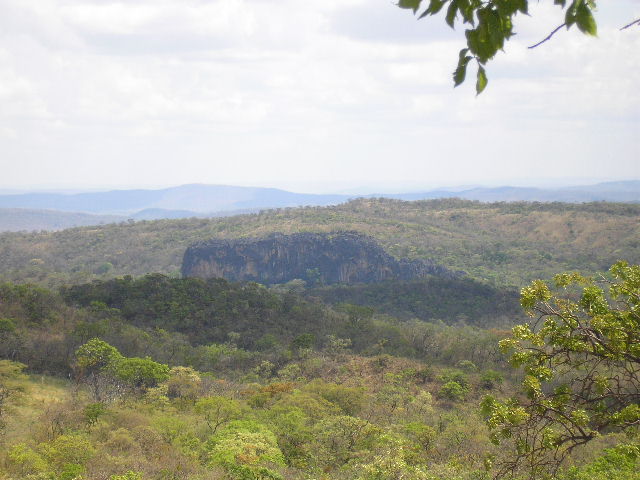Habitat And Geography
 In the daytime maned wolves relax in the cerrado,
forests, and
marshy areas near rivers (Rodden, et al. 2008). Monogamous
couples guard permanent territories that are about 27 km, and
although the male and female use the same spaces, they are only
found
together during the reproduction season (Dietz 1985). (Go to
Reproduction) Maned wolves live in the same
territory and home range throughout their entire life. Also, no maned wolves of
the same gender live in the same territory. The territories are marked by landmarks that are
physical barriers and also site specific defecation spots (Fletchall
1995).
In the daytime maned wolves relax in the cerrado,
forests, and
marshy areas near rivers (Rodden, et al. 2008). Monogamous
couples guard permanent territories that are about 27 km, and
although the male and female use the same spaces, they are only
found
together during the reproduction season (Dietz 1985). (Go to
Reproduction) Maned wolves live in the same
territory and home range throughout their entire life. Also, no maned wolves of
the same gender live in the same territory. The territories are marked by landmarks that are
physical barriers and also site specific defecation spots (Fletchall
1995).
Because maned wolves live solitary lives and have large territories, they are found in low densities throughout the range. It is hard to find the exact population of maned wolves because of their secretive nature. The population is about 13,000 mature maned wolves, and is thought to decline about 10% during the next 10 years (Rodden, et al. 2008). (Go to Threats)
Maned wolves live in South America, in an area called the cerrado. The cerrado is a savanna scrubland ecosystem with vast fields of tall grasslands, wet fields, and fire-resistant scrub forests (canids.org). The range of maned wolves includes all of Paraguay, northeastern Argentina, northwestern Uruguay, extreme southeastern Peru, and central regions of eastern Bolivia and southern Brazil (nationalzoo.si.edu, Dietz 1985). This enormous ecosystem is sunny and windy from April to October, and the rest of the year the region is known for rainy weather and thunderstorms (Roy 2004).


Fossils records of maned wolves were found from the Holocene and late Pleistocene periods in the Brazilian Central Highlands, and since fossil remains are not found elsewhere makes it clear that this species evolved in this region, and the organism is native to South America (Dietz 1985). The cerrado was once covered by Atlantic forests, and before civilization, the different large herds of hooved animals that characterize the African plains in South America didn’t exist. Instead, the South American highlands were grass prairies and scrub forests that flourished with rodents and other small vertebrates (Santos, et al. 2006, Rodden, et al. 2008). Because the maned wolf hunted in this habitat thousands of years ago, it has adapted to this region and has been shaped morphologically and socially. As a result, maned wolves are the most distinct of the South American dog breeds (Dietz 1984). (Go to Classification)
 Ever
since the appearance of humanity, the Brazilian Central Highlands
have been immensely changing. The cerrado grasslands and
forests (picture at right) are being transformed at a phenomenal rate
to farmland (Dietz 1984). After the Amazon, the cerrado is Brazil’s
second largest ecosystem, and it originally covered about 21% of
Brazil’s total land area. Sadly, now less than 20% of the original
cerrado is still intact (Roy 2004). Knowing little about the ecology of maned
wolves, it is tough to determine the effects of the land
changes on this species (Rodden, et al. 2008). As a result of
overgrazing by cattle, burning pastures, and soil
erosion, the amount of food and territory for maned wolves is
decreasing yearly (animalcorner.co.uk). The impact of the loss of
dietary richness in this region also needs to be
studied further (Santos, et al. 2006, Dietz 1984). (Go to
Nutrition)
Ever
since the appearance of humanity, the Brazilian Central Highlands
have been immensely changing. The cerrado grasslands and
forests (picture at right) are being transformed at a phenomenal rate
to farmland (Dietz 1984). After the Amazon, the cerrado is Brazil’s
second largest ecosystem, and it originally covered about 21% of
Brazil’s total land area. Sadly, now less than 20% of the original
cerrado is still intact (Roy 2004). Knowing little about the ecology of maned
wolves, it is tough to determine the effects of the land
changes on this species (Rodden, et al. 2008). As a result of
overgrazing by cattle, burning pastures, and soil
erosion, the amount of food and territory for maned wolves is
decreasing yearly (animalcorner.co.uk). The impact of the loss of
dietary richness in this region also needs to be
studied further (Santos, et al. 2006, Dietz 1984). (Go to
Nutrition)
Because this region used to be covered by Atlantic forest, some think this suggests that the landscape changes happening has increased the territory for "distribution expansion" of the maned wolf (Rodden, et al. 2008, Dietz 1984). There is some evidence that claims that the organism can use the farming land for hunting and resting; but, once again, additional studies are needed to be able to determine how well the maned wolves can endure the severe agricultural efforts (Rodden, et al. 2008).
In a study done by Queirolo, D. et al., they observed recent and historical data to study range shifts of the maned wolf. They found that there has been recent increases in range in eastern Brazil, which is the outcome of the deforestation and the conversion to agriculture land. The northern and eastern ranges of the maned wolf did not yet show any shifts. The largest cutbacks in range were in the southern areas. This species used to live in almost all of southern Brazil, Uruguay, and Argentina. The maned wolves are still present in northeastern, central, and eastern Argentina, and there are few records of the maned wolves in Uruguay and southern Brazil. Queirolo, et al. suggests that the cause of the range loss in the southern areas are probably from “intense anthropogenic pressure combined with limiting abiotic factors such as temperature and humidity” (Queirolo, et al. 2011). Studies need to be done to determine how habitat changes are influencing the range of maned wolves, and consequently South America may be able to improve and coordinate range-wide conservation plans.
To learn more about how this organism hunts and what it eats, go to Nutrition
Back to HOME
